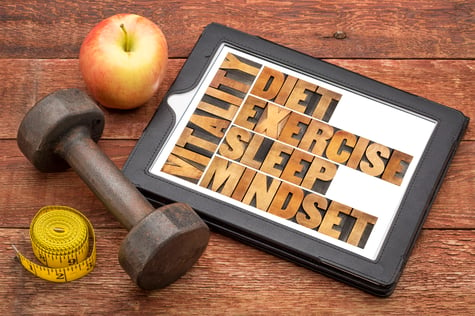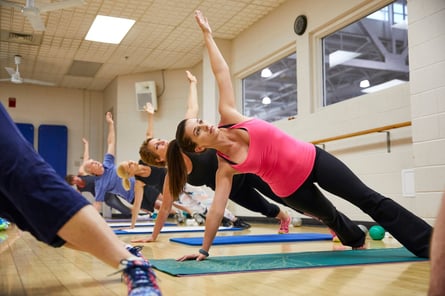 While having a New Year’s Resolution to “lose more weight” isn’t a bad thing, it’s not easy. And depending on how much you want to lose and in what time frame, it’s not always realistic. To benefit your overall health without focusing on your weight, try setting (and sticking to) some of the following nutrition-related resolutions going into 2023.
While having a New Year’s Resolution to “lose more weight” isn’t a bad thing, it’s not easy. And depending on how much you want to lose and in what time frame, it’s not always realistic. To benefit your overall health without focusing on your weight, try setting (and sticking to) some of the following nutrition-related resolutions going into 2023.
Eat More Fruits and Vegetables
About 80 percent of the US population doesn’t meet their fruit intake recommendations, while close to 90 percent do not meet their suggested vegetable intake. The Dietary Guidelines for Americans encourage adults to consume around 2–2.5 cups of fruit per day and 2.5–3 cups of vegetables per day. Although this may be a lot for some, simply aiming to eat one additional fruit or vegetable each day is still beneficial.
Drink More Water
Water is essential for the body. It aids in digestion, regulates body temperature, cushions joints, and helps remove wastes from the body. Not drinking enough water increases the risk for dehydration, which can cause dizziness, confusion, fatigue, headaches and dry skin and mouth. A general rule of thumb is to consume at least 1 milliliter of water for every 1 calorie consumed. For example, if you consumed 2,200 calories per day, you would want to aim to consume 2,200ml, or 2.2 liters of water per day.
Consume Less Alcohol
Excess alcohol intake has both short- and long-term health consequences. In the short term, drinking too much can result in risky behaviors, injury, or violence. Over time, excessive alcohol use can lead to the development of high blood pressure and heart disease, certain cancers, weakened immune system, learning and memory issues, and social problems. Most professional health organizations such as the CDC and WHO agree that men should limit alcohol intake to less than two drinks/day, while women should aim for less than one drink per day.
Decrease Sodium Intake
The Dietary Guidelines for Americans suggest consuming less than 2,300mg of sodium per day to promote optimal health and reduce the risk of heart disease, the leading cause of death for adults in the US. However, in the US, the average sodium intake for individuals older than 1 year of age is ~3,400mg/day. Strategies for reducing sodium intake include cooking at home more often, using herbs and spices to season foods rather than salt, and consuming fewer packaged/prepared foods.
Limit Saturated Fat Consumption
Like sodium, excess saturated fat consumption is linked to an increased risk for heart disease. The Dietary Guidelines for Americans suggest limiting saturated fat intake to less than 10% of daily calories, while the American Heart Association recommends even less, at less than 5–6% of daily calories from saturated fat per day. Saturated fat is found in most animal-based foods such as beef, poultry, pork, full-fat dairy products, and coconut and palm oils. To cut back on saturated fat, reduce your intake or eat smaller portions of the foods listed above and replace them with healthier options, such as fat-free or low-fat dairy and lean cuts of meat.
This blog was written by Lindsey Recker, MS, RD, NIFS Registered Dietitian. To learn more about the NIFS bloggers, click here.


 Let’s be real: a health journey is not always linear and not always easy. Sometimes it can be overwhelming and mucky. What do you do? Where do you start? What if you backslid and need to get back on track? There is so much to health, right? If you try to fix it all at once, you might become overwhelmed and at a greater risk of failure.
Let’s be real: a health journey is not always linear and not always easy. Sometimes it can be overwhelming and mucky. What do you do? Where do you start? What if you backslid and need to get back on track? There is so much to health, right? If you try to fix it all at once, you might become overwhelmed and at a greater risk of failure. 
 Holidays are times when you can relax and reflect, spend time with friends and family, and indulge in copious amounts of turkey, ham, mashed potatoes, and pie. Well, maybe don’t eat so much pie. But we do have plenty of reasons to not only be grateful, and to be inspired for the future.
Holidays are times when you can relax and reflect, spend time with friends and family, and indulge in copious amounts of turkey, ham, mashed potatoes, and pie. Well, maybe don’t eat so much pie. But we do have plenty of reasons to not only be grateful, and to be inspired for the future. Has a physician or other healthcare provider recently told you to improve your diet and exercise? If you are like most Americans, there is also a pretty good chance that you have a stressful lifestyle that leaves you short on the time, money, and energy it takes to implement these changes. Besides, other than a few extra pounds, you haven’t really noticed any changes to your body, right?
Has a physician or other healthcare provider recently told you to improve your diet and exercise? If you are like most Americans, there is also a pretty good chance that you have a stressful lifestyle that leaves you short on the time, money, and energy it takes to implement these changes. Besides, other than a few extra pounds, you haven’t really noticed any changes to your body, right? It’s the end of the day. There was a string of meetings to attend, a pile of emails to answer, an argumentative colleague to work with, maybe even kids yelling for pizza when you had chicken planned for dinner instead. By the time you get home, you’ve already made a plethora of decisions, from how to approach a problem at work to what shoes to wear on your way out the door. You told yourself you would exercise when you got home, but now the couch looks a lot more enticing. All those decisions you made have taken a biological toll on your motivation and self-control, whether you realize it or not.
It’s the end of the day. There was a string of meetings to attend, a pile of emails to answer, an argumentative colleague to work with, maybe even kids yelling for pizza when you had chicken planned for dinner instead. By the time you get home, you’ve already made a plethora of decisions, from how to approach a problem at work to what shoes to wear on your way out the door. You told yourself you would exercise when you got home, but now the couch looks a lot more enticing. All those decisions you made have taken a biological toll on your motivation and self-control, whether you realize it or not. Yoga is pretty popular, and not just in the fitness industry. It’s getting lots of press for its ability to aid in living a generally healthy lifestyle. When people hear about healthy living, they often associate that only with exercise, and sometimes neglect the importance of a balanced diet and de-stressing techniques. Studies are now showing that it’s important to balance out all areas of life; not just one part should have dominance.
Yoga is pretty popular, and not just in the fitness industry. It’s getting lots of press for its ability to aid in living a generally healthy lifestyle. When people hear about healthy living, they often associate that only with exercise, and sometimes neglect the importance of a balanced diet and de-stressing techniques. Studies are now showing that it’s important to balance out all areas of life; not just one part should have dominance.